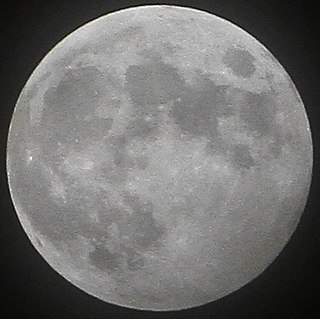
A penumbral lunar eclipse took place on Monday, April 22, 1940. This was a deep penumbral eclipse, with the moon southern limb passing close to the northern umbral shadow.

A penumbral lunar eclipse took place on Monday, April 22, 1940. This was a deep penumbral eclipse, with the moon southern limb passing close to the northern umbral shadow.
| Ascending node | Descending node | |||||
|---|---|---|---|---|---|---|
| Saros | Date Viewing | Type Chart | Saros | Date Viewing | Type Chart | |
| 110 | 1937 May 25  | Penumbral | 115 | 1937 Nov 18  | Partial | |
| 120 | 1938 May 14  | Total | 125 | 1938 Nov 07  | Total | |
| 130 | 1939 May 03  | Total | 135 | 1939 Oct 28  | Partial | |
| 140 | 1940 Apr 22  | Penumbral | 145 | 1940 Oct 16  | Penumbral | |
It was part of Saros series 140.
A lunar eclipse will be preceded and followed by solar eclipses by 9 years and 5.5 days (a half saros). [1] This lunar eclipse is related to two partial solar eclipses of Solar Saros 147.
| April 18, 1931 | April 28, 1949 |
|---|---|
 |  |

A penumbral lunar eclipse took place on 9 February 2009, the first of four lunar eclipses in 2009, and being the deepest of three penumbral eclipses. It also happened on the Lantern Festival, the first since 20 February 1989. The tables below contain detailed predictions and additional information on the Penumbral Lunar Eclipse of 9 February 2009.

A penumbral lunar eclipse took place on 6 August 2009, the third of four lunar eclipses in 2009. The moon's small entry into the Earth's penumbral shadow produced an extremely subtle dimming of the moon's southern edge, difficult to observe visually.

A penumbral lunar eclipse took place on November 20, 2002, the last of three lunar eclipses in 2002.

A penumbral lunar eclipse took place on 18–19 October 2013, the last of three lunar eclipses in 2013.

A penumbral lunar eclipse took place on Sunday, January 31, 1999, the first of two lunar eclipses in 1999.

A penumbral lunar eclipse took place on Sunday, September 6, 1998, the last of three lunar eclipses in 1998.

A penumbral lunar eclipse took place on Friday, March 13, 1998, the first of three lunar eclipses in 1998.

A penumbral lunar eclipse took place at the Moon's ascending node on 11 February 2017, the first of two lunar eclipses in 2017. It was not quite a total penumbral lunar eclipse. It occurred the same day as comet 45P/Honda–Mrkos–Pajdušáková made a close approach to Earth. It also occurred on the Lantern Festival, the first since 9 February 2009. Occurring only 4.4 days after perigee, the moon's apparent diameter was larger.

A penumbral lunar eclipse took place on Friday, July 26, 1991, the third of four lunar eclipses in 1991. This was the 2nd member of Lunar Saros 148. The previous event was on 15 July 1973, and the 1st eclipse of the series. The next event was on 6 August 2009.

A penumbral lunar eclipse took place on Wednesday, January 30, 1991, the first of four lunar eclipses in 1991.
A penumbral lunar eclipse took place on Tuesday, May 15, 1984, the first of three lunar eclipses in 1984. This was a deep penumbral eclipse, with the southern limb of the Moon close to the Earth's shadow.

A penumbral lunar eclipse took place on 10 January 2020. It was the first of four penumbral lunar eclipses in 2020. The moon’s apparent diameter was larger than average because occurred only 3 days before perigee and its distance was 375,887 km.

A penumbral lunar eclipse occurred on Friday, 5 May 2023, the first of two lunar eclipses in 2023. The moon's apparent diameter was 0.1% larger than average because it occurred 5.5 days before perigee. This was the deepest penumbral eclipse since February 2017 and until September 2042.

A penumbral lunar eclipse took place on 30 November 2020. A penumbral lunar eclipse occurs at full moon when the Moon passes through Earth's penumbral shadow.
A penumbral lunar eclipse will take place on Monday, March 25, 2024. It will be visible to the naked eye as 95.57% of the Moon will be immersed in Earth's penumbral shadow.

A penumbral lunar eclipse will take place on Tuesday, August 17, 2027. It will cause a subtle dimming as 54.56% of the Moon will cross within Earth's penumbral shadow.
A penumbral lunar eclipse took place on Saturday, November 6, 1976, the second of two lunar eclipses in 1976, the first being on May 13. This subtle penumbral eclipse may have been visible to a skilled observer at maximum eclipse. 83.827% of the Moon's disc was partially shaded by the Earth, which caused a gentle shadow gradient across its disc at maximum; the eclipse as a whole lasted 4 hours, 25 minutes and 52.1 seconds. Occurring only 0.3 days after apogee, the moon's apparent diameter was 6.5% smaller than average.

A partial lunar eclipse will take place on January 22, 2046.

A total lunar eclipse will take place on March 13, 2044.

A penumbral lunar eclipse took place on Wednesday, October 16, 1940, the last of three lunar eclipses in 1940.